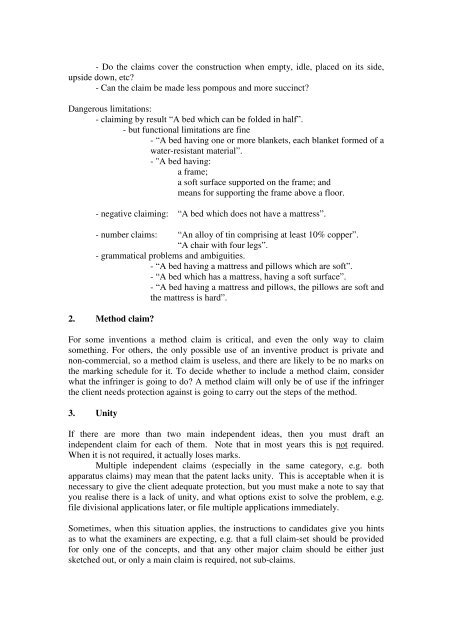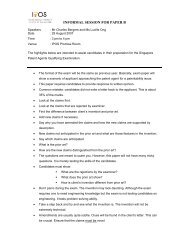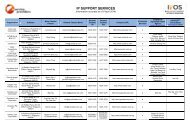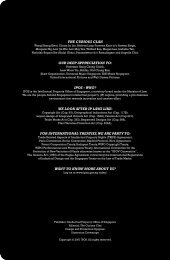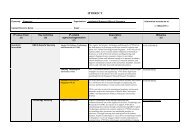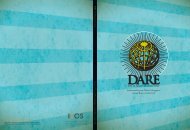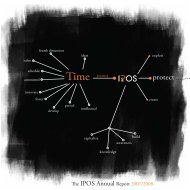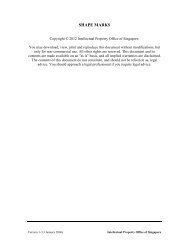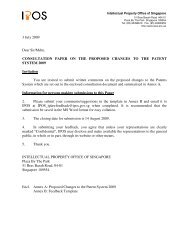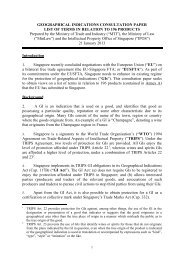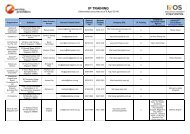Notes on Paper A â Tim Watkin The following notes are a summary ...
Notes on Paper A â Tim Watkin The following notes are a summary ...
Notes on Paper A â Tim Watkin The following notes are a summary ...
Create successful ePaper yourself
Turn your PDF publications into a flip-book with our unique Google optimized e-Paper software.
- Do the claims cover the c<strong>on</strong>structi<strong>on</strong> when empty, idle, placed <strong>on</strong> its side,<br />
upside down, etc?<br />
- Can the claim be made less pompous and more succinct?<br />
Dangerous limitati<strong>on</strong>s:<br />
- claiming by result “A bed which can be folded in half”.<br />
- but functi<strong>on</strong>al limitati<strong>on</strong>s <strong>are</strong> fine<br />
- “A bed having <strong>on</strong>e or more blankets, each blanket formed of a<br />
water-resistant material”.<br />
- "A bed having:<br />
a frame;<br />
a soft surface supported <strong>on</strong> the frame; and<br />
means for supporting the frame above a floor.<br />
- negative claiming: “A bed which does not have a mattress”.<br />
- number claims: “An alloy of tin comprising at least 10% copper”.<br />
“A chair with four legs”.<br />
- grammatical problems and ambiguities.<br />
- “A bed having a mattress and pillows which <strong>are</strong> soft”.<br />
- “A bed which has a mattress, having a soft surface”.<br />
- “A bed having a mattress and pillows, the pillows <strong>are</strong> soft and<br />
the mattress is hard”.<br />
2. Method claim?<br />
For some inventi<strong>on</strong>s a method claim is critical, and even the <strong>on</strong>ly way to claim<br />
something. For others, the <strong>on</strong>ly possible use of an inventive product is private and<br />
n<strong>on</strong>-commercial, so a method claim is useless, and there <strong>are</strong> likely to be no marks <strong>on</strong><br />
the marking schedule for it. To decide whether to include a method claim, c<strong>on</strong>sider<br />
what the infringer is going to do? A method claim will <strong>on</strong>ly be of use if the infringer<br />
the client needs protecti<strong>on</strong> against is going to carry out the steps of the method.<br />
3. Unity<br />
If there <strong>are</strong> more than two main independent ideas, then you must draft an<br />
independent claim for each of them. Note that in most years this is not required.<br />
When it is not required, it actually loses marks.<br />
Multiple independent claims (especially in the same category, e.g. both<br />
apparatus claims) may mean that the patent lacks unity. This is acceptable when it is<br />
necessary to give the client adequate protecti<strong>on</strong>, but you must make a note to say that<br />
you realise there is a lack of unity, and what opti<strong>on</strong>s exist to solve the problem, e.g.<br />
file divisi<strong>on</strong>al applicati<strong>on</strong>s later, or file multiple applicati<strong>on</strong>s immediately.<br />
Sometimes, when this situati<strong>on</strong> applies, the instructi<strong>on</strong>s to candidates give you hints<br />
as to what the examiners <strong>are</strong> expecting, e.g. that a full claim-set should be provided<br />
for <strong>on</strong>ly <strong>on</strong>e of the c<strong>on</strong>cepts, and that any other major claim should be either just<br />
sketched out, or <strong>on</strong>ly a main claim is required, not sub-claims.


